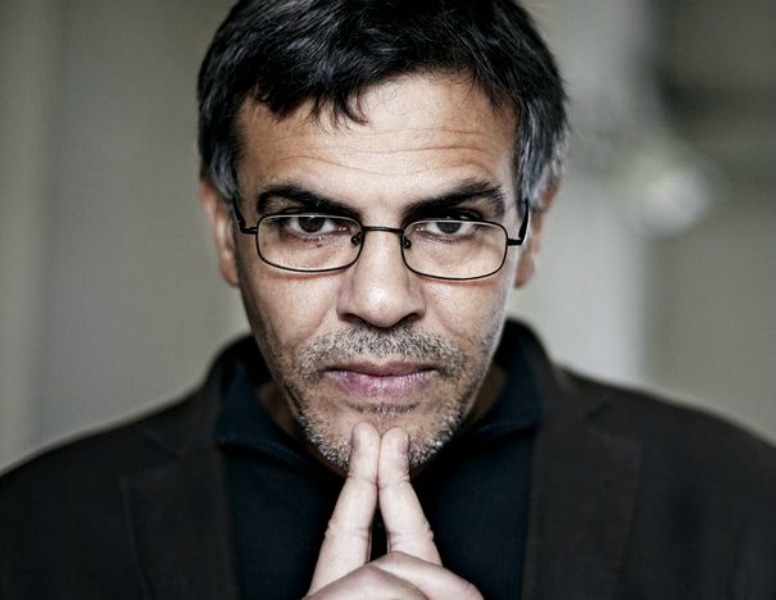Palm d’Or winner Blue Is the Warmest Color has critics riled up like no other film this year.
The Cannes favorite, a coming-of-age tale of two lesbian lovers, has evoked innumerable opinions about director Abdellatif Kechiche’s tight close-ups, self-indulgence and obsession with his heroine’s posterior. Even the author of the graphic novel upon which the film is based — Julie Maroh — derided the movie as “a brutal and surgical display, exuberant and cold, of so-called lesbian sex, which turned into porn.”
Some commentators have gone so far as to question whether a heterosexual male has the right to depict intimate lesbian love scenes on film.
Film Comment’s Critical Dialogue collected some of the most interesting critiques and defenses of the film in this excellent piece.
Check out our interview with Kechiche by Danny Miller, and read on for a beautifully written, insightful analysis of Kechiche by our own Kathleen Murphy, courtesy of Parallax View:
Abdellatif Kechiche’s Moveable Feast
By Kathleen Murphy
Before 2000, Abdellatif Kechiche was an actor, presumably finding pleasure and profit in performance. When he came to make movies, the French-Tunisian gravitated to raw, often nonprofessional performers, faces and bodies fresh to the pressure and invasiveness of the camera eye.
Reviewing Poetical Refugee (originally La Faute à Voltaire), Kechiche’s first film, critic A.O. Scott remarked the new director’s “fine and unusual instinct for ordinary beauty.” That instinct has persisted in all of his subsequent work. And from the start, the former thespian celebrated the saving power of creative presentation of self in theater, dance … even by means of splendid cuisine! For this immigrant artist, body-based connections often generate a sense of home and metaphysical sustenance for his refugees, literal and/or existential.
Games of Love and Chance
Games of Love and Chance (2003) features a tribe of teens who live and thrive in dreary housing projects outside Paris. Typically, Kechiche concentrates on memorable faces and feelings, human landscapes of passion and individuality so richly diverse they totally background the unprepossessing environment.
At one point, some kids meet in a sort of accidental amphitheater, stone steps curving halfway around a grassy flat in a cheerless little park. They’ve gathered to rehearse an 18th-century Marivaux play, Le Jeu de l’amour et du hazard, a comedy of manners about the impossibility of escaping one’s socioeconomic destiny—a topic of special interest in Kechiche’s immigrant tales. Blond, lissome Lydia, a budding diva, is late, and Frida, a dark, frizz-maned Arab beauty, is seriously angry. Pitch-and-catch rants eventuate, ripe with down-and-dirty slang suggesting the modern-day equivalent of the playwright’s famously embroidered language. The others—especially melancholy Krimo, smitten with the lovely Lydia—play rapt audience to the two “stars” acting out a two-hander as stylized as any Marivaux scene.
And then, with scarcely a pause, Lydia elides into her dramatic role, fluttering a fancy fan, flirting archly with her Harlequin. This magical segue, from North African adolescent volatility to sophisticated French sex-and-social satire, is both startling and seamless, signaling an almost enchanted continuity.
By means of theatrical play, the sheer fun of acting out, these beautiful children—not of Marx and Coca-Cola, but of global diaspora—claim existential home ground.
The Secret of the Grain
About one-third of the way through The Secret of the Grain (2007), an extended family of French-Tunisians gathers for a big Sunday dinner. The main course is delicious fish couscous, lovingly prepared by the matriarch of the clan. (The movie’s overseas release title was Couscous.) Kechiche’s handheld camera darts about the table, catching each distinctive face in closeup, as the guests eat and gab with equal gusto. It’s as though you’re seated at the table, pigging out on the rhythms of tribal communication.

‘Secret of the Grain’
Thanks to that up-close-and-personal style—and the “real-time” duration of the scene—the viewer succumbs to the pleasure of breaking bread with this close-knit family, taking joy in how these no-longer “foreign” folk look and speak and connect with one another.
The unemployed patriarch of that family dreams of opening a restaurant in a derelict ship, to introduce the French to distinctive Tunisian fare. When literally everything goes wrong on the inaugural night, it’s the ripe body of a beautiful woman that saves the day, when a daughter of the clan rises to undulate her generous belly in exotic dance. That performance simultaneously measures and closes the distance between her and a restive audience of hungry, one-time colonizers.
Running through these tales about displaced persons is an undercurrent of melancholy, a sense of something lost (the old homeland?) even as new identity is achieved. Isolated souls unable to project their inner thoughts and needs fall by the wayside, while actress, dancer, and feast-maker find themselves, through earthy presentation. Contrary to convention and stereotype, Kechiche’s Arab heroines throw off metaphorical burqas to act out with intoxicating purpose, energy and style.
For Kechiche, character trumps plot every time. If you suffer from cinematic ADD, you’ll have trouble sitting still for this director’s slow, intense exposure of complex humanity, as he encourages us to see ourselves in people we might otherwise write off as irremediably Other. That investment in prolonging his/our gaze in what seems like real time has garnered critical admiration—and more recently, accusations of an “exploitative” directorial eye.


